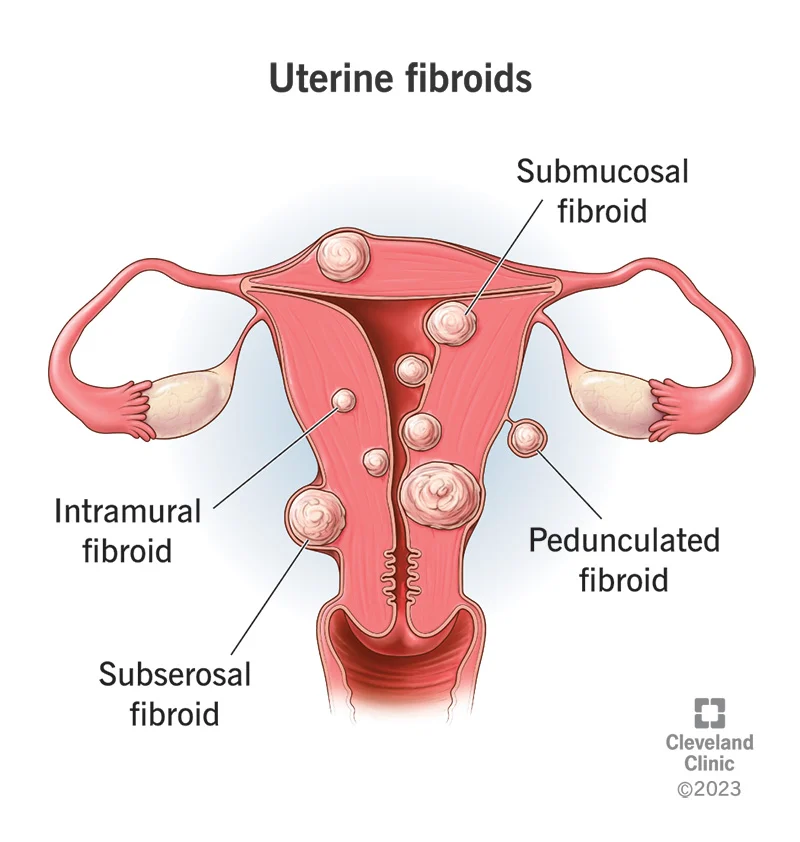Overview of Uterine Fibroids and Myomectomy
Uterine fibroids, also known as leiomyomas or myomas, are benign tumors that originate from the smooth muscle cells in the uterus. These growths can lead to a variety of symptoms and health issues, prompting discussions around treatment options. One of them is myomectomy, a surgical procedure that removes the fibroids while preserving the uterus. Below is a detailed exploration of both uterine fibroids and myomectomy.
Uterine Fibroids
Definition: Uterine fibroids are non-cancerous masses that can develop in the uterus, derived from the smooth muscle tissue. Their formation and growth are influenced by hormonal factors, particularly estrogen and progesterone. Fibroids can exist singly or in groups, and they may vary significantly in size, from as small as a pea to larger than a grapefruit.
Types of Uterine Fibroids:
- Intramural Fibroids: These grow within the muscular wall of the uterus and can cause the uterus to become enlarged. They are the most common type of fibroid.
- Submucosal Fibroids: Positioned just beneath the uterine lining (endometrium), these fibroids can protrude into the uterine cavity, potentially affecting pregnancy and menstrual cycles.
- Subserosal Fibroids: These are located on the outer wall of the uterus and may extend outward, sometimes pressing on adjacent organs, which can cause discomfort or other complications.
- Pedunculated Fibroids: These fibroids are attached to the uterus by a stalk and can either grow within the uterine wall or extend outward. They may cause unusual pain if the stalk twists or becomes ischemic.
Symptoms of Uterine Fibroids:
- Heavy or Prolonged Menstrual Bleeding: Many women experience heavy menstrual flow or bleeding between periods due to fibroids.
- Pelvic Pain or Pressure: The presence of fibroids can create a sensation of fullness or pressure in the pelvic region, resulting in discomfort.
- Frequent Urination: If fibroids are pressing against the bladder, they can lead to an increased need to urinate.
- Complications During Pregnancy: Depending on their size and location, fibroids can contribute to complications in pregnancy, such as the risk of miscarriage or premature labor.
- Infertility or Difficulty Conceiving: Certain types of fibroids may interfere with implantation or pregnancy maintenance.
- Pain During Intercourse: Fibroids can also cause pain during sexual activity, making it uncomfortable.
Diagnosis: Uterine fibroids are typically diagnosed through a combination of pelvic examinations and advanced imaging techniques. Healthcare providers may use ultrasounds, which can visualize the size and number of fibroids, or magnetic resonance imaging (MRI) for more detailed images.
Myomectomy
Definition: Myomectomy is a surgical intervention designed to remove uterine fibroids while preserving the uterus, making it a preferred option for women who wish to maintain their fertility. Myomectomy can help alleviate symptoms associated with fibroids and improve the quality of life.
Types of Myomectomy:
1. Abdominal Myomectomy: This traditional approach involves a larger incision in the abdominal wall, allowing the surgeon to access the uterus and remove larger or multiple fibroids. It’s often recommended for fibroids that are deep within the uterine muscle.
2. Laparoscopic Myomectomy: A minimally invasive method that utilizes several small incisions and a camera (laparoscope) to guide the procedure. This technique is generally associated with less postoperative pain, a shorter recovery period, and minimal scarring, making it suitable for smaller fibroids.
3. Hysteroscopic Myomectomy: This approach involves accessing the uterus through the vaginal canal and cervix, allowing for the removal of submucosal fibroids. It is performed with the help of a hysteroscope, a thin instrument that provides visualization of the uterine cavity, and is typically an outpatient procedure.
Benefits of Myomectomy:
– Preserves the uterus, providing the possibility of future pregnancies.
– Can significantly alleviate symptoms like excessive bleeding and pelvic discomfort.
– Minimally invasive options can lead to quicker recovery times and reduced risk of complications.
Risks and Considerations:
– While myomectomy can relieve symptoms, it does not eliminate the possibility of new fibroids developing in the future.
– Like any major surgical procedure, risks include bleeding, infection, and potential for injury to the uterus or surrounding organs.
– Depending on the extent of the fibroid removal, there may be a risk of complications during future pregnancies.
Making an Informed Decision About Myomectomy
When considering myomectomy, it is critical to engage in thorough discussions with a healthcare provider. Factors to take into account include:
- Fibroid Characteristics: Understanding the size, type, and location of fibroids can influence the choice of surgery.
- Symptom Severity: Assessing the impact of fibroids on daily life and overall well-being is crucial for determining the urgency and necessity of treatment.
- Reproductive Goals: Evaluating current family planning desires and potential future pregnancies should be part of the discussion.
- Potential Risks vs. Benefits: A thorough analysis of the advantages and disadvantages of myomectomy compared to other treatment options, such as medication or hysterectomy, should be undertaken.
Ultimately, the decision to proceed with myomectomy or explore other avenues for treatment will vary based on each woman’s unique health circumstances and personal preferences. Consultation with a knowledgeable medical professional is essential for making informed decisions and achieving optimal health outcomes.
https://my.clevelandclinic.org/health/diseases/9130-uterine-fibroids
https://pmc.ncbi.nlm.nih.gov/articles/PMC9277653/
Discover more from Healthinfo24.com
Subscribe to get the latest posts sent to your email.









Leave a Reply